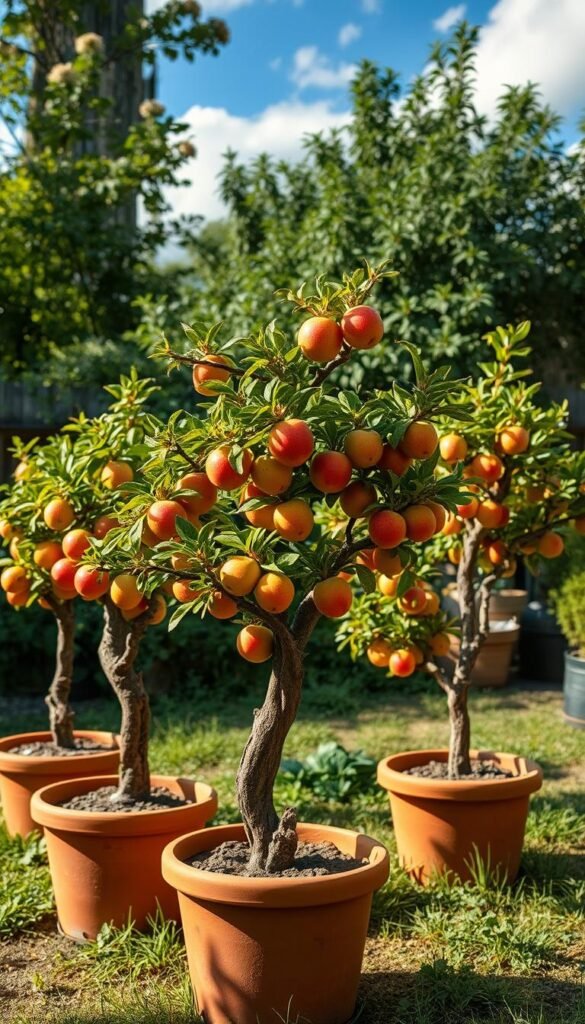Imagine plucking sun-warmed treats steps from your door, even with limited room. Modern growing techniques let any outdoor area become productive, whether you’re working with a narrow balcony or cozy backyard corner.
Specialized plant varieties thrive where traditional orchards can’t. Compact cultivars deliver full-sized flavors while staying under 6 feet tall – perfect for tight spots. With smart training methods, you could harvest over 60 juicy apples from an 8-foot stretch of fence.
Portable solutions let you chase sunlight across patios or shield plants from storms. The secret lies in strategic selection – choosing specimens that match your climate and space constraints. Proper planning ensures your green investments pay off for seasons to come.
You’ll soon discover how manageable these living systems can be. Smaller setups often mean better pest control and easier harvesting. Whether you’re a novice or seasoned grower, fresh possibilities await in every square foot.
Understanding Your Miniature Fruit Garden Space
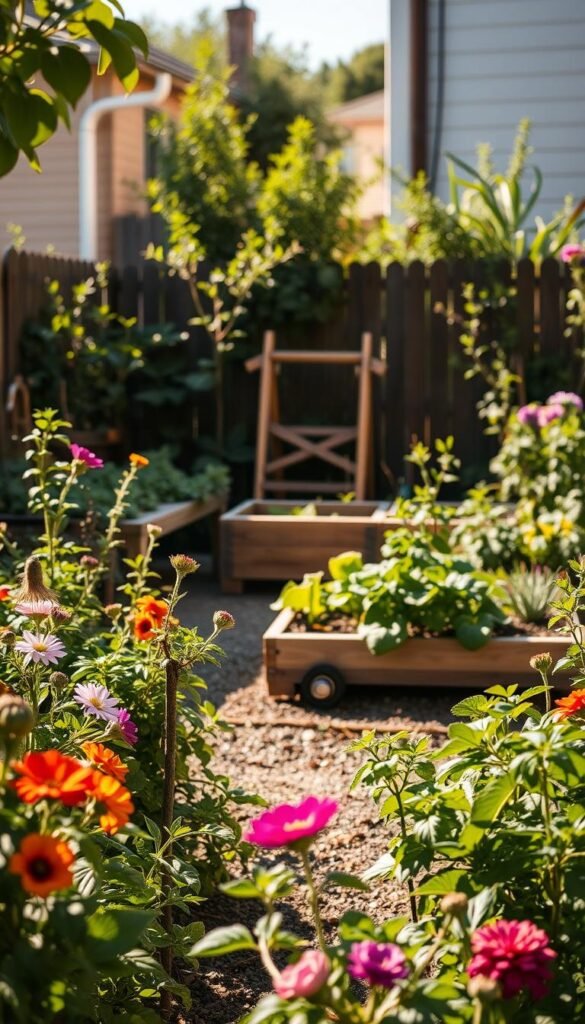
Your yard holds hidden growing zones waiting to be discovered. Even narrow strips along fences or awkward corners can become productive with smart planning. Start by walking your property at different times to spot sunlight patterns and forgotten spaces.
Sunlight Patterns Made Simple
Most fruiting plants need 6-8 hours of direct sunlight. Try this trick: use winter’s full moon position to predict summer sun paths. South-facing walls create warm microclimates perfect for heat-loving varieties, while north-facing zones suit shade-tolerant options like gooseberries.
| Plant | Sunlight Needs | Ideal Locations |
|---|---|---|
| Blueberries | 6 hours | Morning sun areas |
| Apples | 8+ hours | South-facing walls |
| Gooseberries | 4 hours | Partial shade zones |
Water & Climate Essentials
Place your growing area within 15 feet of a water source. Cold air behaves like liquid – it pools in low spots and near solid barriers. Avoid planting in these frost pockets where temperatures drop suddenly. Test soil drainage by digging a 12″ hole and timing how fast water disappears.
Remember: microclimates near paved surfaces can extend your growing season by 2-3 weeks. Use this to your advantage when selecting varieties. Proper site selection now means healthier plants and bigger harvests later.
Choosing the Best Dwarf Fruit Tree Varieties
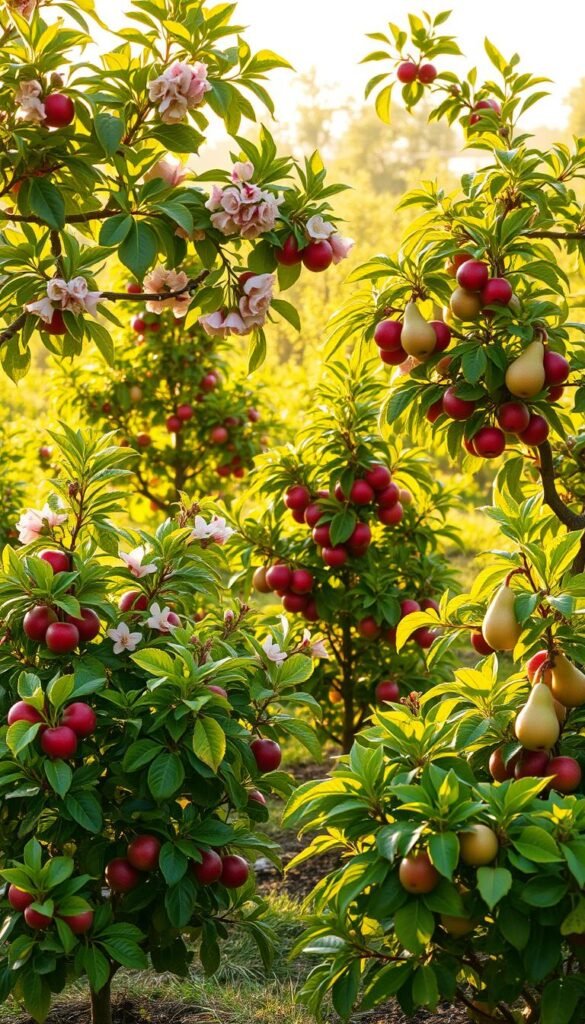
Selecting the right compact growers makes all the difference between frustration and abundance. Many nurseries label plants as “space-saving” while selling specimens that still reach 15 feet tall. Let’s cut through the confusion.
Natural Compact vs. Engineered Solutions
Genetic dwarfs grow like bonsai – their small stature comes from DNA, not pruning. These rare finds produce full-sized treats on 6-foot frames. But options remain limited, especially for challenging climates.
Most modern compact plants use dwarfing rootstocks. These grafted bases control growth but demand extra care. The popular M27 apple base creates patio-friendly 4-footers, yet needs staking and frequent watering. Consider your willingness to provide ongoing support.
| Type | Height | Maintenance | Best For |
|---|---|---|---|
| Genetic Dwarf | 4-6 ft | Low | Busy growers |
| M27 Rootstock | 4-6 ft | High | Precision gardeners |
| Semi-Dwarf | 8-12 ft | Moderate | Traditionalists |
Tailoring Choices to Your Environment
Soil type determines success more than anything else. Blueberries demand acidic earth, while figs tolerate alkaline conditions. Grab a $7 test kit from your local garden store before browsing varieties.
Check USDA zone maps twice – some sellers stretch cold-hardiness claims. For fire blight-prone areas, seek out resistant apple types like Liberty or Enterprise. Your county extension office offers free planting guides matching local pest pressures and weather patterns.
Small Fruit Garden Hacks: Container Options and Dwarf Trees
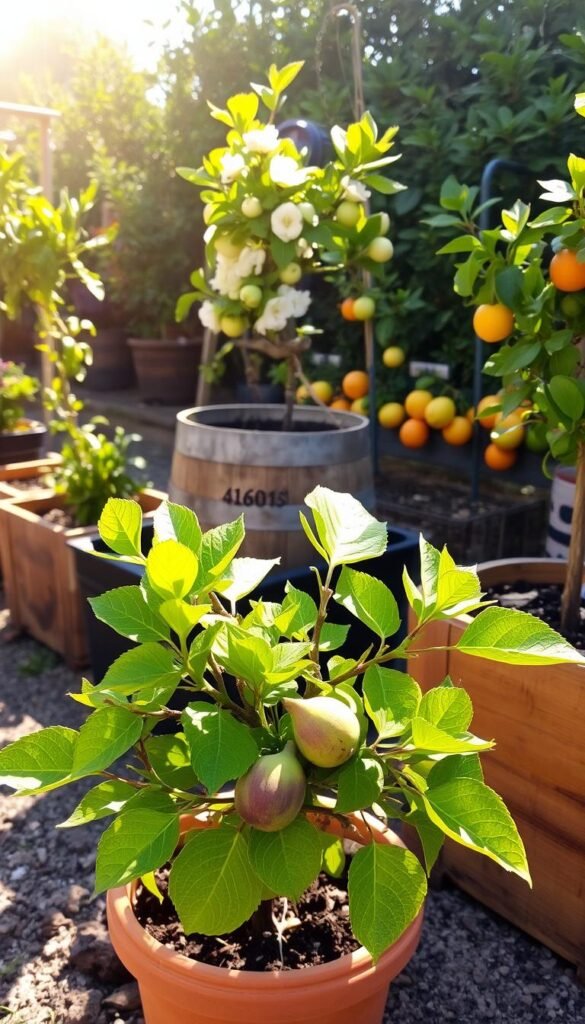
Transform your limited space into a productive oasis with movable growing solutions. Containers unlock fresh possibilities for patios, decks, and urban settings where traditional planting isn’t feasible.
Benefits of Container Growing for Small Spaces
Portable planters let you chase sunlight across your backyard or shield tender specimens during storms. A 24-inch pot accommodates most compact varieties for 5-8 years of growth while maintaining mobility. Fabric containers outperform plastic alternatives by preventing root circling and regulating soil temperature naturally.
| Feature | Fabric Pots | Plastic Pots |
|---|---|---|
| Root Health | Air-pruned system | Circling roots |
| Temperature Control | Breathable material | Heat retention |
| Durability | 3-5 seasons | 5+ seasons |
Create custom soil blends to match your plants’ exact needs, bypassing poor native earth quality. Rotate pots seasonally to maximize vertical space – try staggered shelving for visual appeal and easier harvesting. This approach works particularly well for citrus and figs that thrive in warmer microclimates.
Protect your investment during frost alerts by wheeling specimens into garages or under covered areas. With proper care, container-grown varieties often bear fruit earlier than their ground-planted counterparts, rewarding patience with quicker harvests.
Effective Pruning and Training Techniques
Transform your pruning shears into precision tools for shaping productive trees. Smart training methods help you grow more in less space while keeping plants at arm’s reach. These strategies turn ordinary specimens into high-yield performers for your backyard orchard.
Espaliers, Fans, and Single Cordon Methods
Flat-growing systems unlock vertical spaces. Espaliers train trees against walls or fences using horizontal wires. Casual fan shapes work well for beginners, spreading branches like open hands to catch sunlight.
| Method | Space Needed | Maintenance | Best For |
|---|---|---|---|
| Espalier | 8-10 ft wall | Moderate | Formal layouts |
| Fan | 6-8 ft wall | Low | Quick setups |
| Single Cordon | 3-4 ft row | High | Narrow edges |
Single cordon trees grow at 45-degree angles. This tilt slows vertical growth while boosting fruit production. You’ll get plum-sized harvests from apple varieties that stay under 6 feet tall.
Maintaining Manageable Tree Height for Easy Care
Prune during dormancy and mid-summer to control size. Target water sprouts and inward-facing branches first. Three strategic cuts per year keep trees small enough for ladder-free care.
Multi-plant 2-3 specimens in one hole for natural growth control. Their competing roots create compact forms that extend your growing season. You’ll harvest different varieties from the same footprint for months.
Optimizing Soil Health, Watering, and Seasonal Care
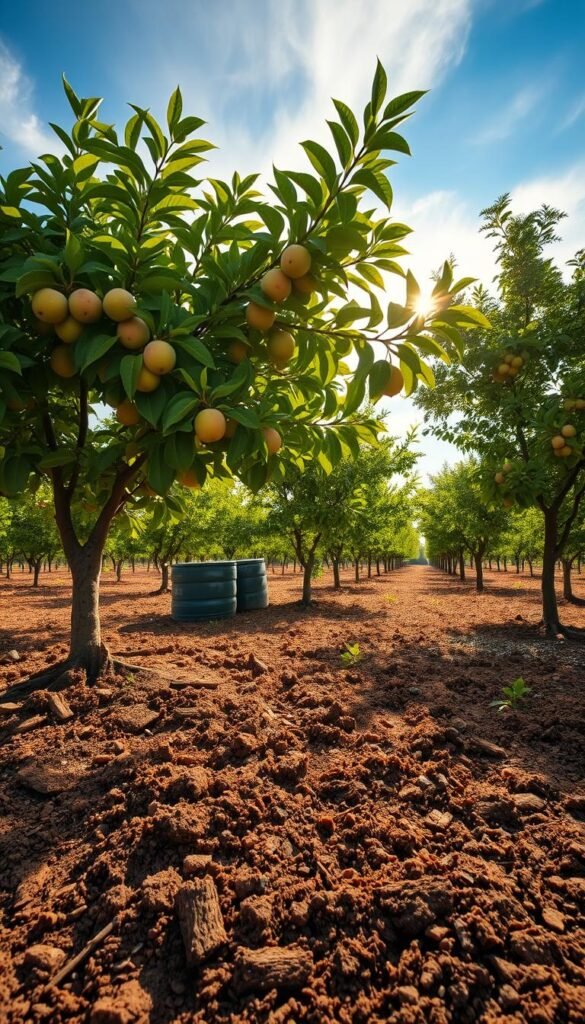
Your plants’ success starts beneath the surface. Proper earth management and hydration habits keep roots thriving through every growth phase. Let’s explore how to create ideal conditions without complicated setups.
Preparing Well-Draining Soil Mixes
Start with a basic potting blend designed for edibles – these contain the right balance of organic matter and drainage agents. Mix in 20% perlite or pumice to prevent waterlogging. Roots need oxygen as much as moisture, so test your blend: squeeze a handful – it should hold shape briefly before crumbling.
| Component | Purpose | Ideal % |
|---|---|---|
| Potting Soil | Nutrient Base | 60% |
| Perlite | Aeration | 20% |
| Compost | Microbes | 15% |
| Worm Castings | Slow-Release Food | 5% |
Guidelines for Watering and Fertilizing Effectively
Check moisture daily using the finger test – water when the top inch feels dry. During flowering phases, increase hydration to every 3 days. “Drip systems prevent shock from sudden dry spells,” notes urban gardener Lisa Chen. Pair this with weekly liquid seaweed feed during active growth months.
Stop fertilizing 6 weeks before your first frost date. This hardening-off period helps plants prepare for dormancy. Watch for yellowing leaves – they often signal nitrogen needs rather than water issues. Balance is key: overfed plants grow lush foliage but sparse fruit.
Container Gardening: Tips and Best Practices
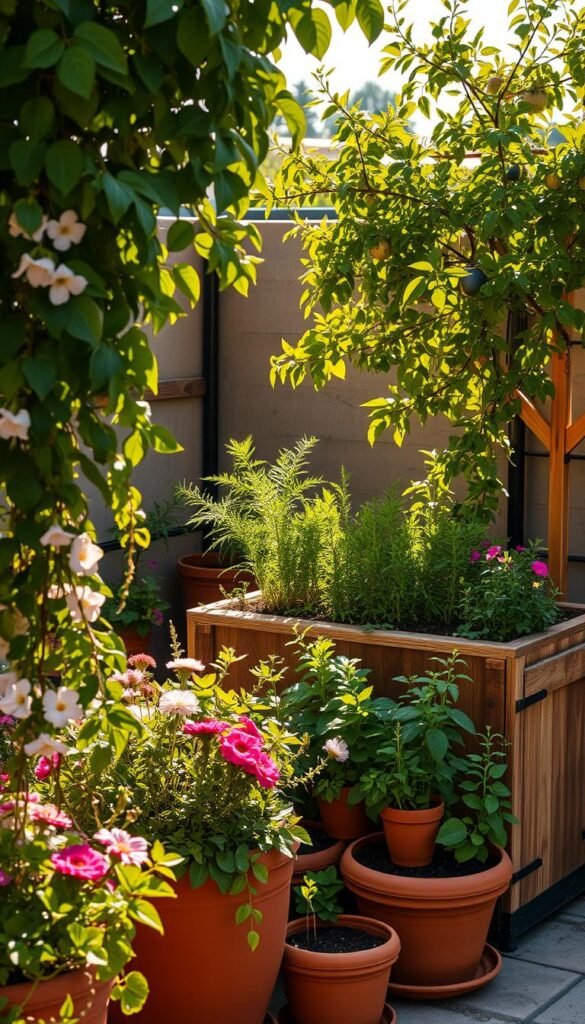
Your container choices shape your garden’s success more than you might realize. Breathable fabric planters and sturdy plastic options each offer unique benefits for different growing needs. Let’s explore how to maximize your setup’s potential while avoiding common pitfalls.
Fabric vs Plastic: Root Health Showdown
Fabric pots outperform traditional materials through natural air-pruning. This process creates dense, healthy roots that absorb nutrients efficiently. Plastic alternatives often lead to circular root growth, which can strangle plants over time.
| Feature | Fabric Pots | Plastic Pots |
|---|---|---|
| Root Development | Fibrous network | Circling pattern |
| Heat Management | Stays 15°F cooler | Retains heat |
| Lifespan | 3-5 years | 5+ years |
| Weight (10-gallon) | 8 lbs empty | 4 lbs empty |
Winter Readiness & Smart Mobility
Container-grown specimens face greater cold risks than ground-planted ones. Insulate pots with bubble wrap or burlap when temperatures drop below freezing. “Moving planters against south-facing walls adds 5-7°F of warmth,” advises horticulturist Mara Simmons.
Consider these strategies for heavy containers:
- Use wheeled dollies before filling with soil
- Place lightweight filler (packing peanuts) in pot bottoms
- Install casters that lock on slopes
| Winter Care Method | Materials Needed | Protection Boost |
|---|---|---|
| Root Blanket | Burlap + straw | +10°F |
| Wall Shelter | South-facing surface | +7°F |
| Mobile Cover | Rolling greenhouse | +15°F |
Remember: A 20-gallon planter weighs 100 pounds when wet. Position heavy containers permanently near water sources, using smaller pots for mobile specimens. This balance keeps your garden adaptable through seasons.
Final Thoughts for a Thriving Mini Orchard
Your journey to a productive backyard orchard begins with thoughtful planning. Combining compact varieties with smart growing methods lets you enjoy fresh flavors without sprawling acreage. Proper care ensures these living investments reward you for years – some dwarf types produce reliably for over a decade.
Match plant choices to your local climate and available sunlight. Rotate containers seasonally to protect tender roots from extreme weather. For mixed edible spaces, explore companion planting with compact veggies like those in our guide to balcony-friendly crops.
Regular pruning maintains manageable sizes while boosting yields. Focus on removing crowded branches to improve air circulation. This simple step reduces disease risks and directs energy into developing plump, juicy fruits.
Remember: even modest efforts compound over time. Start with two or three varieties you love, then expand as confidence grows. With each season, you’ll refine techniques that turn your yard into a personalized produce section.

